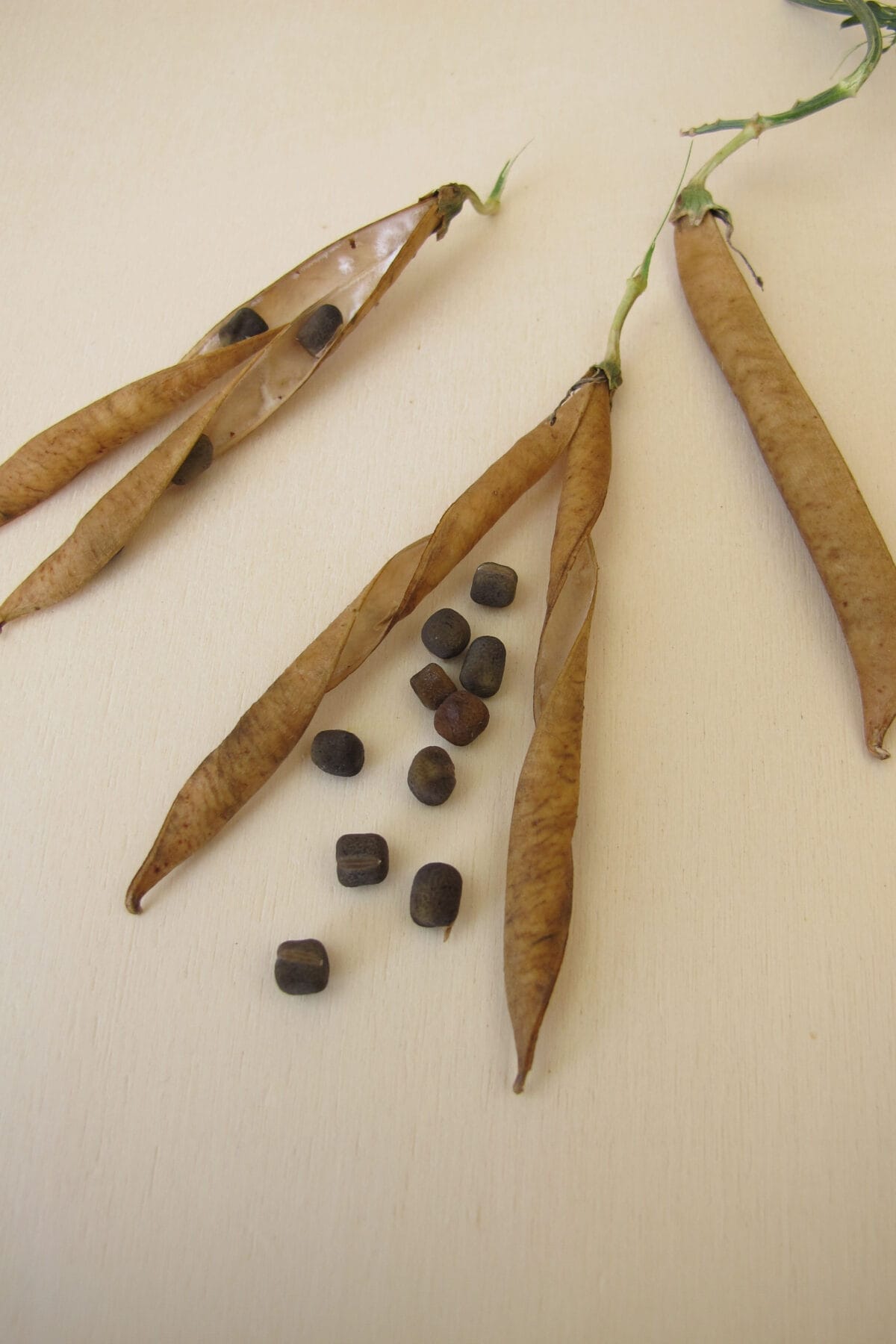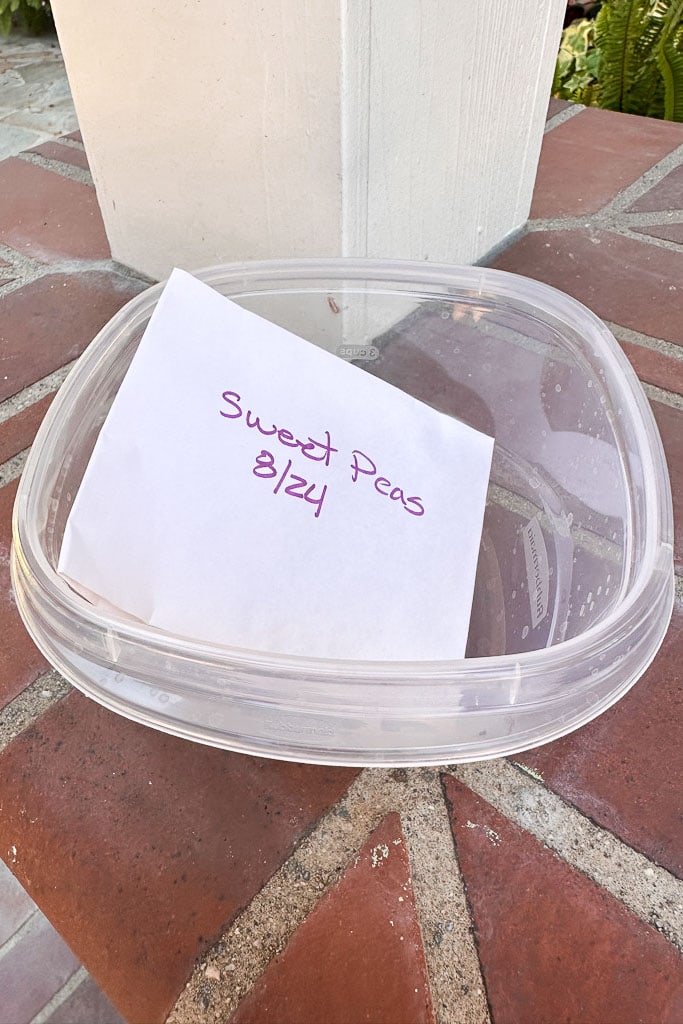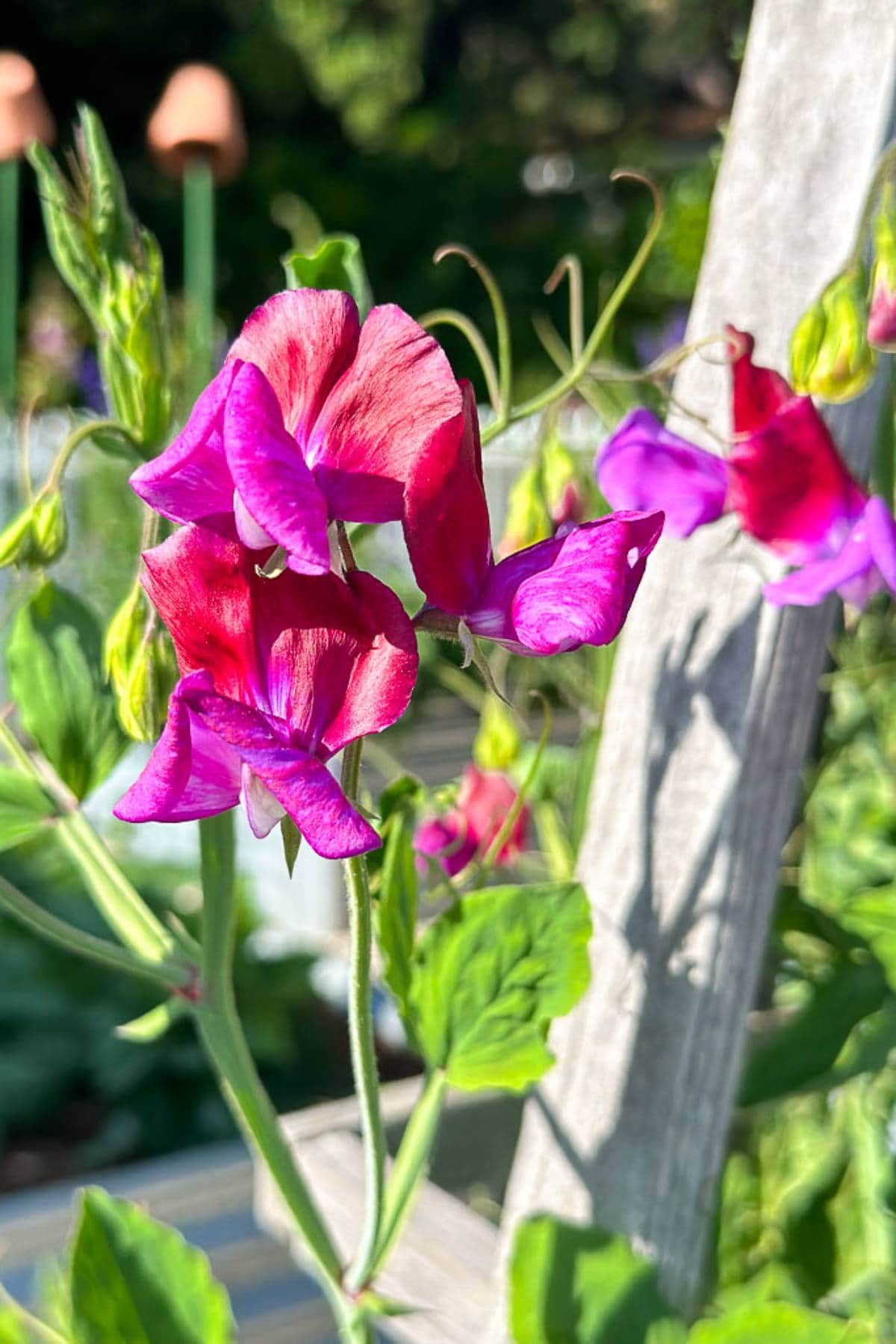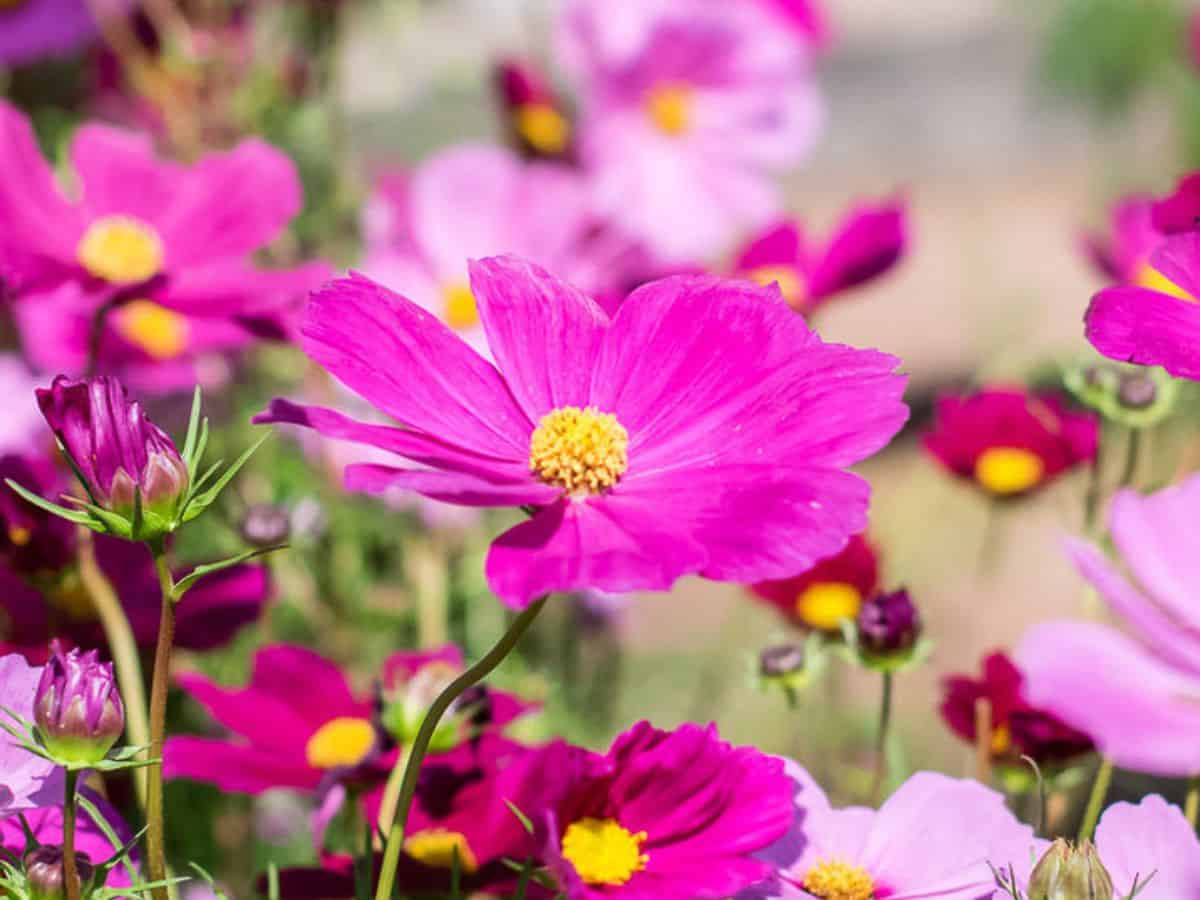Sweet Pea Seeds: How to Harvest, Sow and Grow
Ah, the delightful fragrance of sweet peas! Join me as we harvest, sow, and grow this annual flower (there are also perennial varieties) so your garden is filled with fragrant flowers by late winter—early spring.

On my blog WM Design House, I may sometimes use affiliate links, which means a small commission is earned if you purchase via the link. The price will be the same whether you use the affiliate link or go directly to the vendor’s website using a non-affiliate link. Read my full disclosure policy here.
Sweet Peas
Imagine the delicate blooms and sweet fragrance of sweet peas (Lathyrus odoratus) gracing your cutting garden. Beloved for their beauty, these plants are a favorite in many gardens, including mine. Harvesting their seeds, sowing them at the right time, and providing proper care can ensure a vibrant display year after year. Collecting seeds from mature pods allows you to preserve your favorite varieties and continue their legacy in your garden. With a little attention to timing and planting techniques, you can enjoy the charming beauty of these delicate flowers from season to season. These sweet pea plants tend to bloom from late winter into early summer.
Sweet pea seeds are small, round, and have a hard seed coat, typically dark brown or black. They are harvested from mature seed pods once they turn a papery brown color. Sweet pea seeds are easy to collect and store, making them ideal for gardeners who want to grow their plants from seed.

Harvesting Sweet Pea Seeds
Here’s a simple guide to harvesting sweet pea seeds. As the summer heat sets in, the plants will dry up and turn brown, making this the ideal time to harvest your seeds. Wait for the dried pods to turn a papery, brown color, then carefully remove them from the plant. This way, you’ll have several new plants next year.

When to Harvest Sweet Pea Seeds
The timing for harvesting sweet pea seeds depends on your growing zone. I usually harvest my seeds in Southern California (Zone 10b) in late July or early August. However, in most other parts of the country, sweet pea seeds are typically ready for harvest closer to early September, at the end of the growing season.
Signs that the pods are ready
To know when sweet pea pods are ready for harvesting, watch for several key signs. The most important indicator is the color and texture of the pods: they should turn from green to light brown, resembling the appearance of a paper bag. The pods will also feel dry and brittle to the touch, and you may hear a slight rustling sound when they are shaken, signaling that the seeds inside have matured and loosened. At this stage, the pods may start to split slightly along their seams, another sign that the seeds are fully developed and ready to be collected.

Best time of day to harvest
The best time to harvest sweet pea seeds is in the early morning, ideally on a dry day when any dew has evaporated. Morning harvesting ensures that the seeds are cool and not exposed to the intense heat of the day, which can affect their viability. A dry day prevents moisture from seeping into the seed pods, reducing the risk of mold or rot during storage.
Tip from wendy’s garden:
Collect your seeds on a flat tray lined with a paper towel to avoid the seeds from sliding around
How to Collect Sweet Pea Seeds
Tools Needed
- Garden Gloves – Protect your hands while handling the plants and pods.
- Pruning Shears or Scissors – For clean-cut seed pods from the plant.
- Paper Bags or Envelopes – Collect and store the seeds, allowing them to breathe and remain dry.
- Marker or Pen – To label the paper bags or envelopes with the seed variety and date of harvest.
- Tray or Flat Surface – To spread the seeds out to dry after harvesting, ensure they don’t retain moisture.
- Paper Towel: Line your tray with a paper towel.
Techniques for Collecting Seeds from Sweet Pea Flower
A simple technique for saving the pea-like seeds from the garden is gently squeezing the dried sweet pea seed pods along their seams. Hold the pod over a clean tray or bowl, then use your fingers to carefully apply pressure along the seam until the pod splits open. Once open, use your thumb to brush the seeds out into the tray or bowl gently. Use caution. This method helps prevent seeds from scattering and makes collecting them all in one place easy. Afterward, spread the seeds in a single layer on the tray and leave them in a cool, dark place for a few days to ensure they are completely dry before storing them.

Tip from wendy’s garden:
When clipping the pods, hold a large baggie underneath to collect them. Then, shake the bag well, and many seeds will fall out of the pods.
Harvesting and Storing Sweet Pea Seeds
To properly store sweet pea seeds, place them in a paper bag or envelope, allowing air circulation and preventing moisture buildup that could lead to mold or rot. Ensure the paper bag or envelope is labeled with the seed variety and the collection date to keep track of freshness. Store the seeds in a cool, dry place, such as a cupboard, pantry, or drawer, away from direct sunlight and humidity. A temperature of around 40-50°F (4-10°C) is ideal for seed storage.

Tips for saving sweet pea seeds
To further protect the seeds, consider placing the paper bags inside an airtight container, such as a glass jar with a lid or a plastic container with a tight seal. This added layer helps protect against any potential pests or unexpected humidity changes. Check on the seeds occasionally to ensure they remain dry and will be ready to sow when the planting season arrives.

Tip from wendy’s garden:
Be sure to write on the envelope the name of the seeds and the date.
Sowing Sweet Pea Seeds
Choosing the right location
Choosing the right location to plant sweet peas is essential for healthy growth and a vibrant display of flowers. Sweet peas thrive in a spot with plenty of sunlight—ideally, at least six to eight hours of full sun each day. While they can tolerate light afternoon shade, especially in hotter climates, they perform best with ample morning sunlight.

Sweet peas prefer well-drained, fertile soil rich in organic matter.

Tip from wendy’s garden:
Add perlite to your soil. It improves drainage, and perlite also retains some moisture, providing a balance that helps keep the soil hydrated without becoming waterlogged. This is especially useful for plants that prefer well-drained but consistently moist soil.
Preparing the Soil

Preparing well-drained soil is crucial, as sweet peas do not like their roots soaked. Follow my directions below for the best results.
- Mixing in compost or fertilizer: The ideal soil for sweet peas is loamy, which means it has a balanced mix of sand, silt, and clay. This provides good drainage while retaining enough moisture for the roots. To enrich the soil, incorporate organic matter like compost, well-rotted manure, or leaf mold to improve its texture and nutrient content in your garden beds.
- Tilling and leveling the soil—Tilling and leveling the soil creates a loose, even bed that helps to create well-drained soil and root penetration, providing an ideal environment for sweet peas to thrive.
- Soil PH– The best soil pH for sweet peas is between 6.5 and 7.5, which is neutral to slightly alkaline. This pH range allows sweet peas to absorb nutrients effectively, promoting healthy growth and abundant flowering.
- If the soil is too acidic (below 6.5), you can raise the pH by adding garden lime. For soils that are too alkaline (above 7.5), incorporating organic matter like compost or peat moss can help to balance the pH. Regularly testing the soil can help you maintain the optimal pH for growing sweet peas.

Sowing the Seeds


- Depth and spacing guidelines—When directly planting sweet peas, Place a seed about 1 inch (2.5 cm) deep in the soil. Space the seeds 2 to 3 inches (5 to 7.5 cm) apart for climbing varieties or 6 to 8 inches (15 to 20 cm) apart for bush varieties to allow ample room for growth and airflow.You want to be sure to plant any seeds after the last spring frost.
- Planting indoors—To give your plants a head start, you can start them indoors. Place a small amount of soil in peat pots and sow seed below the soil surface. Cover the top of the seed with some soil to ensure good germination.
- Watering sweet pea seedlings– The best way to water these young plants is to gently water them at the base using a watering can with a fine spout or a spray nozzle set to a light mist. This prevents disturbing the delicate roots and avoids splashing soil onto the leaves, which can lead to fungal diseases. Keep the soil moist but not soggy, ensuring it does not dry out completely.
Growing Sweet Peas
Growing sweet peas is relatively easy. Follow a few guidelines, and you will have fragrant sweet peas for a couple of weeks to months in your garden. They provide lovely cut flowers.



- Support structures– Provide a trellis, fence, or other support for sweet pea vines to grow upwards, encouraging healthy growth and abundant blooms.
- Pest control strategies – Check sweet pea plants for early signs of pests like aphids, slugs, snails, and spider mites. Early detection makes it easier to manage pests before they cause significant damage
- Neem Oil or Insecticidal Soap: Use neem oil or insecticidal soap to control common pests like aphids, spider mites, and powdery mildew. Apply these organic treatments directly to the affected areas, following the product instructions for safe use.
- Natural Predators: Encourage beneficial insects like ladybugs, lacewings, and predatory beetles that feed on aphids and other pests. Plant companion flowers such as marigolds, alyssum, or dill to attract these natural predators.
Caring for Sweet Peas
- Fertilization– The best fertilizer for sweet peas is a balanced, all-purpose fertilizer with an equal ratio of nitrogen, phosphorus, and potassium (such as a 10-10-10 or 20-20-20 formula). Alternatively, a fertilizer formulated for flowering plants, which is slightly higher in phosphorus to encourage blooms, can also be effective. Seaweed emulsion is also a favorite for feeding sweet peas.
- Avoid high-nitrogen fertilizers, as these can promote excessive leaf growth at the expense of flowers. Instead, opt for a slow-release granular fertilizer at planting time, followed by a diluted liquid fertilizer every 4-6 weeks during the growing season to support continuous blooming. Additionally, incorporating compost or aged manure into the soil before planting can provide a steady source of nutrients and improve soil health.
- Watering– The best way to water sweet peas is to provide deep, consistent watering at the base of the plant, ensuring the soil stays evenly moist but not waterlogged. Water in the morning to allow excess moisture to evaporate throughout the day, reducing the risk of fungal diseases. Use a soaker hose or drip irrigation system to deliver water directly to the root zone, avoiding wetting the leaves, which helps prevent mildew and other leaf diseases. Increase the watering frequency during hot or dry weather to maintain consistent moisture levels. However, always allow the top inch of soil to dry slightly between waterings to prevent root rot.
- Prune regularly– Regular pruning is beneficial for sweet peas to encourage continuous blooming and healthy growth. Deadheading, or removing spent flowers, is essential to prevent the plant from setting seeds, which would otherwise signal the plant to stop producing new flowers.
Harvesting Sweet Pea Flowers

Signs that Beautiful Sweet Peas are Ready to be Picked
- Full Bloom: The flowers are fully open, displaying their vibrant colors and characteristic shape, but not starting to wilt or fade. Harvesting at this stage ensures the flowers are at their most fragrant and visually appealing.
- Firm Petals: The petals should feel firm and not show any signs of browning or curling at the edges. This indicates that the flowers are fresh and in peak condition for harvesting.
- Strong Stem: The stems should be sturdy and firm, not floppy or weak. Strong stems will hold up better in arrangements and last longer once cut.
- No Visible Seed Pods: If you want to prolong blooming, harvest the flowers before seed pods form. Once the plant produces seeds, it reduces flowering and focuses on seed development.
To cut the flowers, identify a healthy stem and cut just above a leaf node or a pair of leaves. This encourages new growth and additional flower production.

Sweet peas generally do not have the longest vase life, typically lasting 4 to 7 days when cut. Harvest the flowers early in the morning when they are most hydrated to maximize their vase life and place them in water immediately. Cutting the stems at an angle and refreshing the water daily can help extend their freshness.
Wrapping Up
In summary, growing sweet peas can be a rewarding experience, offering a stunning display of colorful and fragrant blooms throughout the season. By understanding their planting needs, providing the right care, and managing pests effectively, you can enjoy these beautiful flowers in your garden year after year. Whether growing annual or perennial varieties, following these simple tips will help you cultivate healthy, vibrant sweet peas that add charm and fragrance to any outdoor space.
Common FAQ’s About Sweet Peas
Q: How long do sweet peas take to germinate?
A: Sweet pea seeds usually take about 10 to 14 days to germinate, depending on soil temperature and conditions.

Q: How tall do sweet peas grow?
A: Climbing varieties of sweet peas can grow up to 6 to 8 feet tall or more, while bush varieties are more compact, growing about 1 to 3 feet tall.

Q: How can I encourage more blooms on my sweet peas?
A: To encourage more blooms, deadhead spent flowers regularly, provide consistent watering and fertilization, and ensure they receive plenty of sunlight.


Other Gardening Posts from WM Design House
If you love this post about sweet pea seeds, you might also enjoy some of my other favorite gardening posts:
39 of the Best Perennials
Make Your Own Plant Fertilizer
Are Zinnias Perennials



More about me!

Hello, I’m Wendy – a dedicated homemaker with a deep passion for decorating, gardening, cooking, and crafting. I find joy in harmonizing beautiful elements to fashion a space that is both comfortable and inspiring. I will help you create a beautiful home, one project at a time.










love your Sweet Peas! and your gardening instructions are amazing!
Thank you, Patty. I love spending time in the garden It’s my happy place.